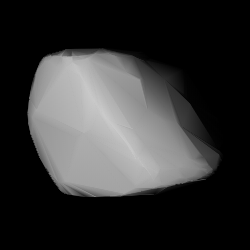
1983 Bok is a dark background asteroid from the central region of the asteroid belt. It was discovered on 9 June 1975, by American astronomer Elizabeth Roemer at the Catalina Station of the UA's Steward Observatory in Tucson, Arizona, and named for Bart Bok and Priscilla Fairfield Bok. The carbonaceous C-type asteroid has a rotation period of 10.7 hours and measures approximately 15 kilometers in diameter.
1810 Epimetheus, provisional designation 4196 P-L, is a stony Florian asteroid from the inner regions of the asteroid belt, approximately 8 kilometers in diameter.

1552 Bessel, provisional designation 1938 DE1, is a stony Eoan asteroid from the outer regions of the asteroid belt, approximately 18 kilometers in diameter. It was discovered on 24 February 1938, by Finnish astronomer Yrjö Väisälä at Turku Observatory in Southwest Finland, and named after German astronomer Friedrich Bessel.
1575 Winifred, provisional designation 1950 HH, is a stony Phocaea asteroid and slow rotator from the inner regions of the asteroid belt, approximately 9.5 kilometers in diameter.
1024 Hale, provisional designation A923 YO13, is a carbonaceous background asteroid from the outer regions of the asteroid belt, approximately 45 kilometers (28 miles) in diameter. The asteroid was discovered on 2 December 1923, by Belgian–American astronomer George Van Biesbroeck at the Yerkes Observatory in Wisconsin, United States. It was named for American astronomer George Ellery Hale. The dark C-type asteroid may have a rotation period of 16 hours.
1033 Simona, provisional designation 1924 SM, is a stony Eoan asteroid from the outer regions of the asteroid belt, approximately 20 kilometers in diameter. The asteroid was discovered by George Van Biesbroeck in 1924, who named it after his daughter Simona.
1213 Algeria is a carbonaceous asteroid from the outer region of the asteroid belt, approximately 32 kilometers in diameter. Discovered by Guy Reiss at Algiers Observatory in 1931, it was named after the North African country of Algeria.
1617 Alschmitt, provisional designation 1952 FB, is an assumed carbonaceous asteroid from in the outer parts of the main belt, approximately 30 kilometers in diameter. It was discovered on 20 March 1952, by French astronomer Louis Boyer at Algiers Observatory in Algeria, Northern Africa, and named after French astronomer Alfred Schmitt.

1457 Ankara, provisional designation 1937 PA, is a stony asteroid from the central region of the asteroid belt, approximately 18 kilometers in diameter. It was discovered on 3 August 1937, by German astronomer Karl Reinmuth at Heidelberg Observatory in southwest Germany, and later named for the Turkish capital city of Ankara.
3960 Chaliubieju, provisional designation 1955 BG, is a stony asteroid from the central regions of the asteroid belt, approximately 9 kilometers in diameter. It was discovered on 20 January 1955, by astronomers at the Purple Mountain Observatory in Nanjing, China. The asteroid was named after Cha Liubieju, a friend of one of the discoverers.

1804 Chebotarev is a stony background asteroid from the inner regions of the asteroid belt, approximately 10 kilometers in diameter. It was discovered on 6 April 1967, by Russian astronomer Tamara Smirnova at the Crimean Astrophysical Observatory in Nauchnyj on the Crimean peninsula. The asteroid was named after Soviet astronomer G. A. Chebotarev.
3936 Elst, provisional designation 2321 T-3, is a stony Vestian asteroid from the inner regions of the asteroid belt, approximately 5 kilometers in diameter. The asteroid was discovered on 16 October 1977, by Dutch astronomer couple Ingrid and Cornelis van Houten at Leiden, on photographic plates taken by Dutch–American astronomer Tom Gehrels at Palomar Observatory in California, United States. It was named after Belgian astronomer Eric W. Elst.
1995 Hajek, provisional designation 1971 UP1, is a metallic asteroid from the middle region of the asteroid belt, approximately 13 kilometers in diameter.
1460 Haltia, provisional designation 1937 WC, is a stony background asteroid from the central regions of the asteroid belt, approximately 8 kilometers in diameter. It was discovered on 24 November 1937, by Finnish astronomer Yrjö Väisälä at the Iso-Heikkilä Observatory in Turku, Finland. The asteroid was named after Halti (Haltia), Finland's highest peak on the border to Norway.
1780 Kippes, provisional designation A906 RA, is an Eoan asteroid from the outer regions of the asteroid belt, approximately 28 kilometers in diameter. It was discovered on 12 September 1906, by astronomer August Kopff at the Heidelberg-Königstuhl State Observatory in southwest Germany. The asteroid was named after German Catholic priest and amateur astronomer Otto Kippes.
4147 Lennon, provisional designation 1983 AY, is a stony Vestian asteroid and a potentially slow rotator from the inner regions of the asteroid belt, approximately 7 kilometers in diameter. It was discovered by American astronomer Brian Skiff at Lowell's Anderson Mesa Station on 12 January 1983. It was later named after musician John Lennon.
1190 Pelagia, provisional designation 1930 SL, is a dark Nysian asteroid from the inner regions of the asteroid belt, approximately 17 kilometers in diameter. It was discovered on 20 September 1930, by Soviet–Georgian astronomer Grigory Neujmin at the Simeiz Observatory on the Crimean peninsula. The asteroid was named after astronomer Pelageya Shajn.
1393 Sofala, provisional designation 1936 KD, is a Vestian asteroid from the inner regions of the asteroid belt, approximately 11 kilometers in diameter. It was discovered on 25 May 1936, by South African astronomer Cyril Jackson at the Union Observatory in Johannesburg. The asteroid was named after the province of Sofala in Mozambique.
1844 Susilva, provisional designation 1972 UB, is a stony Eoan asteroid from the outer region of the asteroid belt, approximately 22 kilometers in diameter. It was discovered on 30 October 1972, by Swiss astronomer Paul Wild at Zimmerwald Observatory near Bern, Switzerland, and later named after a schoolfriend of the discoverer.
1544 Vinterhansenia, provisional designation 1941 UK, is a dark asteroid from the inner regions of the asteroid belt, approximately 22 kilometers in diameter. It was discovered on 15 October 1941, by Finnish astronomer Liisi Oterma at Turku Observatory in Southwest Finland, and named for Danish astronomer Julie Vinter Hansen.




